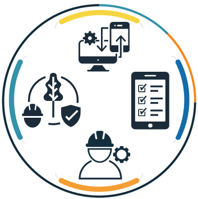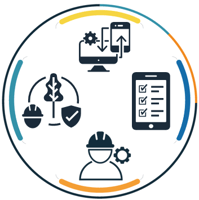5 min read
Two (Surmountable) Roadblocks on the Path to Smarter Cities
By: Chris Moustakas on October 20, 2016

A few weeks ago I attended BridgeSF, a conference organized by a non-profit group in San Francisco called City Innovate, which works to bridge the communication divide between public and private sectors – two sectors that get along about as well as Jets and Pats fans.
The conference was specifically about Smart Cities, and the challenge of aligning public and private interests to create communities that are sustainable, affordable, and efficient, even as their population density increases. San Francisco likes to think of itself as ground zero for this sort of thing, but it’s by no means the only one making plans: from Paris to Hong Kong, every major metropolis is working on it.
Honestly, the whole idea is tremendously exciting. We’re heading towards a future that is safer, greener, and more efficient. When all is said and done, traffic jams and smog will be a thing of the past – but as I listened to the presentations, two classes of problems stood out, at least to me, as barriers to progress: trust and incentives.
To explain what I mean by trust, take something as basic as coordinating rides, which is something many of us already do but will need to happen on a much bigger scale if we’re to reduce congestion on the roads. I’ve got a ten-year-old boy that likes to play football. Since both my wife and I work, we split carpooling duties with other families. Following is a transcript of a recent conversation between my wife and two other parents that shows how ridiculous the logistics can get:
T: Just confirming I’m taking the boys to football, right? I can pick up D then get A, J, and & I after the retreat.
W: I’m working from home tomorrow and I told J I’d give E a ride home after the retreat. The boys need to be picked up at 3pm but doesn’t D get out of school at 3:30? Why don’t I just pick up the boys and E, give E a ride home and bring the boys to my house, then you can pick up D then get the boys at my house to go to practice?
T: D’s class is at a retreat too. He needs to be picked up at 2:30 from Golden Gate Park. Okay I will come to your house. I can’t bring A home though.
W: Are your boys bringing their football bags to the retreat? T, can you bring I’s bag with you and I will leave A’s at home. It will be tight in the car with four boys and a bag but we can do it to E’s house.
G: I have a big car. Why don’t I just drive? I can drop E home on the way.
W: Are you planning on driving to practice then? I’ll need to find a way for A to get home.
G: Wait, I just heard from R that he’s taking J to practice. And I have to take D2 to 2pm soccer practice now.
W: Okay then, let’s do this…
All this is over text messages, and it goes on for much longer. Looking at it, you’d think it’s an impossible problem to solve, but technologically it’s not that big a deal. It’s a complicated traveling salesman problem, to be sure, but given the right inputs and enough horsepower, it’s well understood how to solve it (look up NP-complete problems if you’re interested).
The bigger issue, though, is thedata. What if someone needed to stop by a grocery store on the way home, or just got back from the doctor and is now on crutches? To really make something like this work, you need:
- Everyone to sign up (easier said than done)
- Vehicle profiles, like how many they can seat (not too hard)
- Real-time input from calendars and last-minute needs (doable)
- Real-time information on where people are (hard)
- Real-time information on where their kids are (really hard)
- Of course you could just enter locations manually, but how inconvenient is that, and how could you possibly coordinate everyone entering their information at roughly the same time? Ideally, you need real-time, automatically updated data. What would make you comfortable enough to share that data with a third party?
And this is just one use case. There are many more things we could make simpler by sharing data we fight hard to protect. Smart cities boil down to optimized interactions, but you can’t optimize what you can’t access. Efficiency and privacy are paths that lead to diametrical end states. To make this work will require compromise and a major focus on cyber security.
The second obstacle has to do withincentives. Cities won’t get smart without involvement from both the private and public sectors, which operate under completely different incentive models. Governments have a fiduciary responsibility to taxpayers; companies are expected to risk everything and if it looks like they’re going to fail, get it over with quickly and move on to the next idea. Governments are driven by the public good; companies are driven by profit.
How do you incentivize private industry to do things that may not be obvious revenue generators? One idea mentioned at the conference was that of the “triple bottom line (TBL),” which I found super interesting as it was the first I’d heard of it. Rather than derive a company’s value solely by its revenue, derive it from a larger framework consisting of social, environmental, and financial measures.
Of course, you can’t make groups pay attention to accounting they don’t value. Shareholders will want share prices to rise, and that will almost always be driven by revenues and profits. But if a favorable TBL valuation lets a company, say, tap into a dedicated subset of the $66B a year the General Services Administration spends, then all of a sudden a company’s share prices will rise whether shareholders care about non-financial measures or not.
And while on the one hand government wields a carrot, in the other it can wield a stick – for example, through more stringent control of ads. When the government decided that, for the public good, smoking had to decrease, it blocked smoking ads from television. No one disputes that as a bad move by Big Brother; it’s self-evidently the right thing to do.
One speaker suggested that, if we want to change people’s behavior so they drive less and take public transportation more, we can start by making car advertisements illegal – the air waves aren’t owned by Ford, after all. And just as you can still buy packs of cigarettes, they’re just heavily taxed, high-density regions like cities could tax single-person use of cars during peak periods. If it costs an extra $20 to drive downtown on your own at 8am on a Monday, maybe the bus starts to look like a good idea.
I’m not sure I’m on board with these specific changes – I certainly don’t want to spend an extra $20 to drive downtown, although I also wouldn’t mind never having to sit through another inane car commercial – but what’s clear is that it’s going to take both carrots and sticks to change behavior, and we’re all going to have to make sacrifices.
There’s no doubt that the road to smarter cities will be a long, windy, muddy mess littered with stalled vehicles, accidents, and construction-zone gridlocks. But the obstacles are surmountable, the destination has an air of inevitability about it, and getting there will be tremendously exciting for everyone involved.
Related Posts
New SEC Greenhouse Gas Reporting Rules Passed
On March 6, the U.S. Securities and Exchange Commission (SEC) adopted new rules for climate-related...
New Name, While Offering Expanded Delivery Capacity & Product Footprint
DevonWay customers may have noticed a subtle change recently – that we have a new name! Since our...
DevonWay and JBJBusinessGroup Partner to Modernize Legacy Systems at Government Organizations
We're excited to announce our recent partnership with government consultant JBJBusinessGroup, Inc.,...






